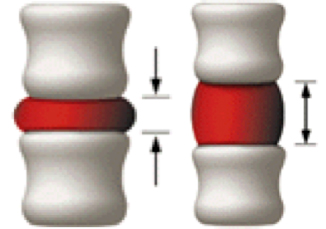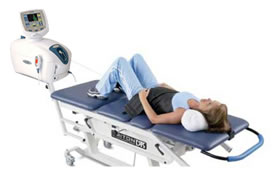
Non-Surgical Spinal Decompression: A Revolutionary Spinal Pain Treatment
Say goodbye to chronic back and neck pain — without surgery or meds. Spinal decompression therapy at Waves of Wellness is gentle, safe, and effective.
In January 2001, the FDA gave clearance to a technology that began four decades earlier with the space program. When astronauts returned from their space missions, scientists found that the astronauts were inches taller than they were before they left. Research discovered that the lack of gravity allowed their spinal discs to actually rehydrate and get taller!
What resulted was reproducing “no gravity” here on Earth to help people with disc injuries.
Several attempts were made before the FDA cleared the product now known as non-surgical
spinal decompression.
See, as you are sitting there reading this, you (along with the help of gravity) are putting
400 mmHg pressure on each disc in your lower back. If you were to stand up and bend
over to pick something up, you would double the pressure on your discs. It’s no wonder that
repetitive bending or heavy lifting is a common cause of disc injury to the lower back.
And if you have one of these “hidden subluxations” in your spine, you are literally risking severe injury just by living in Earth’s gravity!
The FDA has measured the intra-discal pressure of the disc during spinal decompression at somewhere between NEGATIVE 150-200 mmHg! This negative pressure helps your injured discs in 3 ways:
- Negative pressure creates a vacuum within the disc that literally pulls the disc material back into the center.
- When this disc material is sucked back in, the pressure on the nerve(s) is relieved and the pain goes away.
- At the same time, this vacuum effect pulls oxygen, water, and nutrients into the disc to help heal up the torn disc cartilage. This stabilizes the disc and prevents problem from returning.

 There was a study published in the Orthopedic Technology Review of 219 patients, which is a large number of patients as far as studies go. The patients had a variety of different problems. Some had single-level disk herniations, and others had multiple levels that were bulging. Some had more back than leg pain and others had mostly sciatica. The results were that about 86% of the patients obtained substantial relief. That is a very large percentage in terms of anything else that is out there. There are currently studies ongoing to more fully evaluate the effectiveness of spinal decompression. We have found in the four years we’ve been using decompression in our office, a success rate of 90% (9 of 10 patients) when combining decompression with treating the patient’s muscle imbalances (like we spoke of earlier).
There was a study published in the Orthopedic Technology Review of 219 patients, which is a large number of patients as far as studies go. The patients had a variety of different problems. Some had single-level disk herniations, and others had multiple levels that were bulging. Some had more back than leg pain and others had mostly sciatica. The results were that about 86% of the patients obtained substantial relief. That is a very large percentage in terms of anything else that is out there. There are currently studies ongoing to more fully evaluate the effectiveness of spinal decompression. We have found in the four years we’ve been using decompression in our office, a success rate of 90% (9 of 10 patients) when combining decompression with treating the patient’s muscle imbalances (like we spoke of earlier). Each decompression session takes less than an hour. 15 minutes is spent with the doctor prior to decompression, then 30 minutes on the decompression table.
Each decompression session takes less than an hour. 15 minutes is spent with the doctor prior to decompression, then 30 minutes on the decompression table.